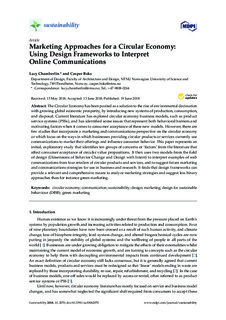| dc.contributor.author | Chamberlin, Lucy | |
| dc.contributor.author | Boks, Casper | |
| dc.date.accessioned | 2018-09-05T11:37:59Z | |
| dc.date.available | 2018-09-05T11:37:59Z | |
| dc.date.created | 2018-07-31T20:30:38Z | |
| dc.date.issued | 2018 | |
| dc.identifier.issn | 2071-1050 | |
| dc.identifier.uri | http://hdl.handle.net/11250/2560956 | |
| dc.description.abstract | The Circular Economy has been posited as a solution to the rise of environmental decimation with growing global economic prosperity, by introducing new systems of production, consumption, and disposal. Current literature has explored circular economy business models, such as product service systems (PSSs), and has identified some issues that represent both behavioral barriers and motivating factors when it comes to consumer acceptance of these new models. However, there are few studies that incorporate a marketing and communications perspective on the circular economy or which focus on the ways in which businesses providing circular products or services currently use communications to market their offerings and influence consumer behavior. This paper represents an initial, exploratory study that identifies ten groups of concerns or ‘factors’ from the literature that affect consumer acceptance of circular value propositions. It then uses two models from the field of design (Dimensions of Behavior Change and Design with Intent) to interpret examples of web communications from four retailers of circular products and services, and to suggest future marketing and communications strategies for use in business and research. It finds that design frameworks can provide a relevant and comprehensive means to analyze marketing strategies and suggest less binary approaches than for instance green marketing. | nb_NO |
| dc.language.iso | eng | nb_NO |
| dc.publisher | MDPI | nb_NO |
| dc.rights | Navngivelse 4.0 Internasjonal | * |
| dc.rights.uri | http://creativecommons.org/licenses/by/4.0/deed.no | * |
| dc.title | Marketing Approaches for a Circular Economy: Using Design Frameworks to Interpret Online Communications | nb_NO |
| dc.type | Journal article | nb_NO |
| dc.type | Peer reviewed | nb_NO |
| dc.description.version | publishedVersion | nb_NO |
| dc.source.volume | 10 | nb_NO |
| dc.source.journal | Sustainability | nb_NO |
| dc.source.issue | 6 | nb_NO |
| dc.identifier.doi | https://doi.org/10.3390/su10062070 | |
| dc.identifier.cristin | 1599245 | |
| dc.description.localcode | © 2018 by the authors. Licensee MDPI, Basel, Switzerland. This article is an open access article distributed under the terms and conditions of the Creative Commons Attribution (CC BY) license (http://creativecommons.org/licenses/by/4.0/). | nb_NO |
| cristin.unitcode | 194,61,45,0 | |
| cristin.unitname | Institutt for design | |
| cristin.ispublished | true | |
| cristin.fulltext | original | |
| cristin.qualitycode | 1 | |

